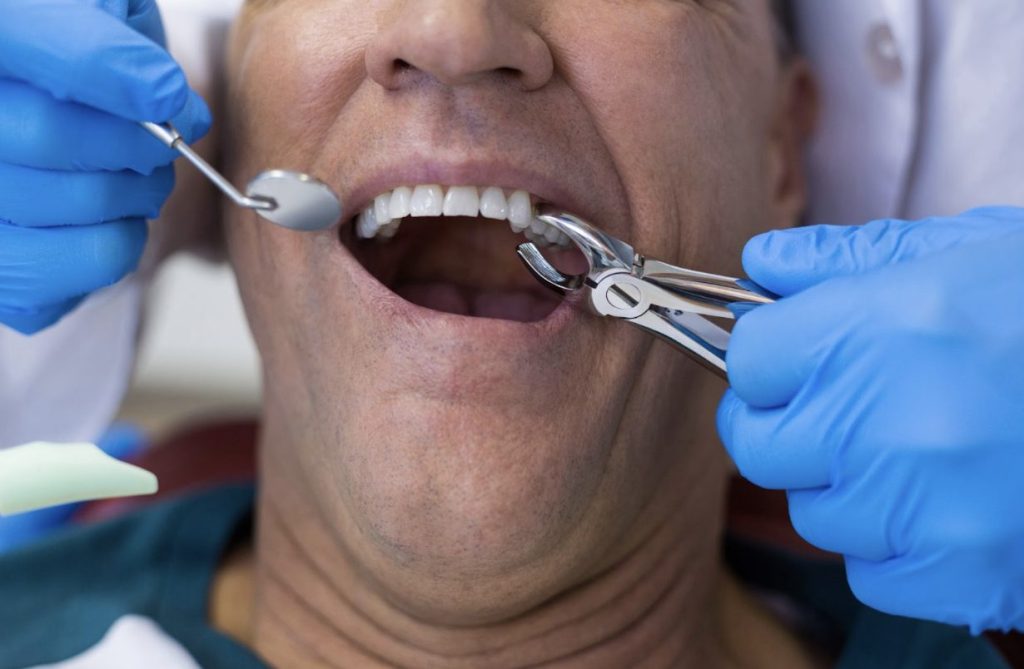Are you experiencing tooth pain or dealing with a dental issue that requires extraction? Don’t worry, you’re not alone. Tooth extraction is a common dental procedure that many people undergo at some point in their lives. In this comprehensive blog, we will guide you through the entire process of tooth extraction, from understanding the necessity of extractions to the different classifications of extractions. Whether you’re facing an upcoming extraction or simply curious about the process, this blog has got you covered with all the information you need.
Defining Tooth Extraction
Tooth extraction involves the removal of a tooth from its socket in the bone. Dentists or oral surgeons typically perform this procedure. It is done for various reasons, such as severe decay, infection, crowding, or trauma. The process includes numbing the area with local anesthesia and using specialized instruments to loosen and remove the tooth. Aftercare instructions may involve managing pain, avoiding certain foods, and maintaining good oral hygiene.
The Necessity of Tooth Extractions
Tooth extractions are necessary in various situations, such as severe decay, infection, overcrowding, or trauma. Dentists assess the need for extraction through examinations and X-rays. During the procedure, the area is numbed with local anesthesia, and the tooth is carefully removed using specialized tools. After extraction, patients may experience discomfort and swelling, which can be managed with pain medication and cold compresses. Proper aftercare instructions, including avoiding certain foods and maintaining good oral hygiene, are provided by dentists.
Preparing For Tooth Extraction
Preparing for tooth extraction involves several important steps. Firstly, it is necessary to determine the need for extraction, which may be due to severe decay, infection, or crowding. Secondly, dental examinations and X-rays are conducted to assess the condition of the tooth and surrounding structures. Different types of extractions, such as simple extractions and surgical extractions, are available based on the complexity of the case. During the actual extraction, anesthesia is used to ensure comfort, and the tooth is removed. Aftercare instructions are provided for a smooth recovery.
Extraction Procedure
Pre-extraction preparation involves a thorough examination of the tooth and X-rays to determine the best approach. The dentist then uses specialized tools to carefully loosen and remove the tooth from its socket. Depending on the complexity, stitches may be necessary to close the wound. Aftercare instructions are provided, including how to care for the extraction site and manage any discomfort or swelling. The healing process typically takes a few days to a week.
What to Expect After Tooth Extraction?
After tooth extraction, it is common to experience bleeding and swelling. Your dentist will provide post-operative instructions on managing pain and swelling. Soft foods and avoiding strenuous activity are recommended. Maintaining oral hygiene and keeping the extraction site clean is crucial to prevent infection.
Effective Pain Management Post Extraction
After tooth extraction, it is common to experience some discomfort. Your dentist will prescribe pain medication to help manage the pain. Over-the-counter pain relievers like ibuprofen can also reduce pain and swelling. Applying an ice pack to the extraction site can provide temporary relief by reducing swelling and numbing the area. It’s important to follow your dentist’s instructions for taking prescribed pain medication and to avoid activities that may disrupt the healing process and increase bleeding.
Dental Hygiene Practices Post Extraction
After tooth extraction, maintaining good dental hygiene is crucial for promoting healing and preventing infection. To keep the extraction site clean, gently rinse your mouth with warm saltwater several times a day. Avoid brushing the extraction site for the first 24 hours, but continue to brush and floss your other teeth regularly. Be cautious when eating, sticking to soft foods, and avoiding chewing on the side of the extraction site. Follow any prescribed pain medication from your dentist and refrain from smoking or using straws.
How to Ensure Proper Aftercare Following Extraction?
To ensure proper aftercare following a tooth extraction, it is important to follow the dentist’s instructions for pain management and medication. Avoid strenuous activities for 24 hours and stick to soft foods. Keep the extraction site clean by rinsing gently with warm saltwater.
Guidelines on Eating Post Extraction
Following a tooth extraction, it’s crucial to adhere to certain guidelines for proper healing and to prevent complications. One essential aspect of post-extraction care is adhering to dietary restrictions, especially in the immediate aftermath of the procedure. It is recommended to consume a soft food diet for the first few days after extraction, including options such as mashed potatoes, yogurt, smoothies, scrambled eggs, and soups. It is important to avoid hard or crunchy foods that can irritate the extraction site or get stuck in the socket. Gradually reintroduce solid foods based on the advice provided by your dentist or oral surgeon.
The Significance of Regular Dental Checkups
Regular dental checkups play a crucial role in maintaining oral health and preventing the need for future tooth extraction. During these checkups, dentists can identify any issues early on and provide necessary treatments or interventions to address them. By following proper aftercare instructions post-extraction, such as avoiding hot or cold foods, rinsing with salt water, and taking prescribed pain medication, healing can be promoted and complications can be minimized. This emphasizes the importance of regular dental checkups in preventing future tooth extraction and ensuring optimal oral health.
Conclusion
Tooth extraction is a common dental procedure that may be necessary due to various reasons such as tooth decay, gum disease, or overcrowding. It is important to understand the process and what to expect before, during, and after the extraction. Contact us today at South Dayton Smiles for more!

 Meet Dr. Botti
Meet Dr. Botti Meet Dr. Scranton
Meet Dr. Scranton
 Patient Forms
Patient Forms Online Bill Pay
Online Bill Pay Benefit Program
Benefit Program Your First Visit
Your First Visit